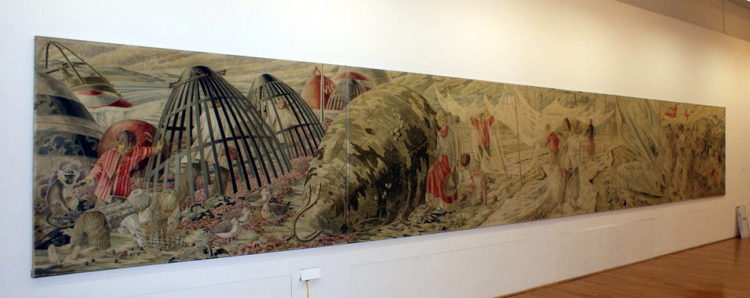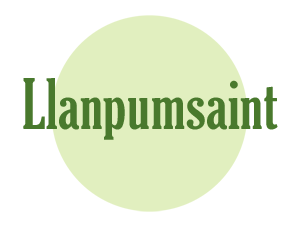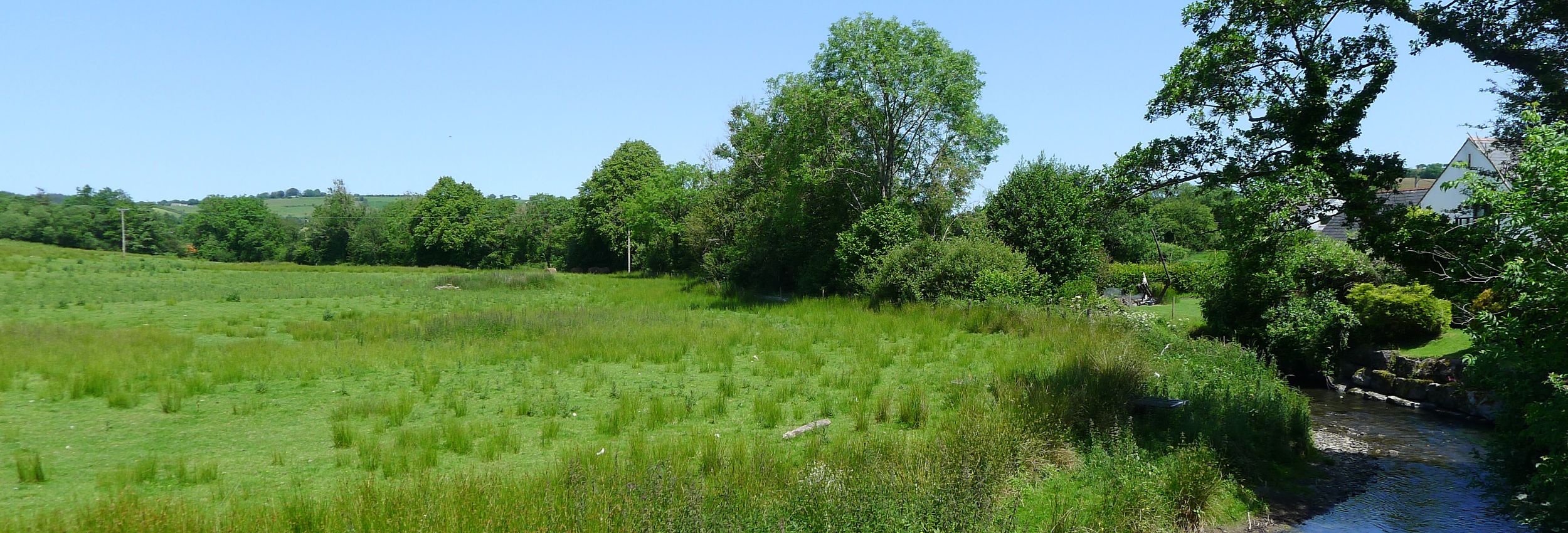Life and times of M.E.Eldridge
M.E.Eldridge – The Designer of the East Window, Llanpumsaint Church

In 1953 the Painter M.E.Eldridge received a commission from the Robert Jones Agnes Hunt Orthopaedic Hospital in Gobowen to paint a mural which would display on the walls of the nurses’ dining room at the hospital. This must be one of the most astonishing and until recently neglected artistic masterpieces of the 20thc.

A gallery of photos from Glyndŵr University of the mural can be seen here
The doctors, Menzies and Salt, had seen some of the innovatory work being carried out in hospitals in Sweden where Art was introduced into hospitals as a part of other therapies. A sum of £500 was offered for a mural. Elsi, as she was known, commenced work. The mural was completed some 5 years later.

For many years the panels hung on the walls of the room for which it was designed. However with developments at the hospital the mural was removed and placed in storage. Last year through an arrangement between the Hospital and Glyndwr University, the painting was recovered and taken to the University in Wrecsam to be restored. Glyndwr University has been building a new Creative Arts Centre. In consultations between the University and the architects it has been possible to design the foyer of the new building to display the mural and it is now displayed in the foyer of the new Creative Arts Building at Glyndwr University here in Wrecsam. The mural is called The Dance of Life It is painted in oil colour on canvas, rather than directly onto a wall.
Who was the woman who painted it? And how did it come about that it was she that the hospital approached, and on what basis?
A brief account of the themes of the mural was provided in The Spring 1991 Issue of The Illustrated, The Journal of The Robert Jones and Agnes Hunt Orthopaedic and District Hospital. There are a number of accounts of the mural. One was provided by Louis Behrend, who became a close friend of Elsi, and had, with his wife Mary, commissioned Stanley Spencer to paint the murals for the Sandham Memorial Chapel in Burghclere near Newbury; another was that provided by the Art Historian Alan Powers, who drew attention to the mural in the pages of Country Life and another by Marie Carter, the archivist at the hospital who for many years oversaw the safety of the painting.
The central theme of the mural is the alienation of man from the natural rhythms of life and the natural world and the attempt, in spite of war, to reclaim a lost innocence and natural wisdom. In 1953 ecology, the pollution caused by industrialisation, the value of the environment were hardly themes at the forefront of most people’s thoughts. The war had only ended some 8 years ago and rationing was hardly dispensed with.
The early panels show scenes of peasant life. The seasonal festivals and practices of harvest and bee keeping are celebrated. From here we move to a starker world where the scenes are of the bleak Welsh coast and of scenes where in which experience and the products, mechanisation and pollution of the civilised world confront and threaten innocence; and finally the restorative and healing powers of some human practices such as relief aid and medicine are pictured. Throughout there are small and acutely observed and detailed images of birds, plants, and particularly children. Elsi herself wrote that she had tried to incorporate into the mural ‘most good ideas’ that she had hitherto had. After viewing the mural Stanley Spencer himself wrote very favourably.
.
So who was M.E. Eldridge? How had she come to be there? And how did she come to be able to paint such a masterpiece?
If you know of her at all you will probably know of her as the wife of R.S.Thomas. She is the woman to whom RS addressed some of the most moving Love Poems of the 20thc. You will be familiar with the poem ‘A Marriage’, perhaps also ‘Comparisons’ but there is a lesser known poem ‘The Way of It’ which has a poignancy directly related to her life as a painter, a mother and a wife.
At the time the mural was being painted she was living, as the wife of RS in the Rectory in Manafon, between Y Trallwng and Y Drenewydd. She had been married for some 13 years and had a young son. This, the consequence of what RS writes in one of his Autobiographies, Neb, “as the war was coming to an end the Rector’s wife expressed the desire to have a child!” She was born in London in 1909. Her father, who came from a background of Gloucestershire yeomen was making his way variously as a pawnbroker and then a jeweller. He was also a Freemason. Her mother was from a Huguenot background, one consequence of which was that Elsi spent some parts of her early years in the Jura in France and spoke French. She attended Wimbledon School of Art and then in 1931 graduated from the Royal College of Art- at that time under the directorship of William Rothenstein. She was taught by Charles (Cyril) Mulroney and Tonks, Eric Ravilious and Edward Bawden. She was a contemporary of Violet Martin and Evelyn Dunbar, sometimes referred to as ‘Lost Heroines’. I think you will see that M.E.Eldridge is also one of those. Her friends and acquaintances include the artists Tom Hennell and Vincent Lines, G.K Chesterton, the writer HJ Massingham ++
To graduate she presented a painting called ‘The Dance of the Bees’. This was eventually transformed into one of the panels of ‘The Dance of Life’ and on graduation from the RCA she won, to her delight, the RCA Travelling Scholarship. Whereas the prestigious Prix de Rome required study at The British School in Rome, her award enabled her to travel where she wished. So she travelled to Italy, to stay in Rome, Florence, Venice, Ravenna, and move into a circle of painters, writers and Art Historians centred round both the Bernard and Mary Berenson’ Villa at I Tatti and the friends of Aubrey and Lina Waterfield at their Villa in Poggio Gherardo outside Aulla, where she went eventually to live.
Lina Waterfield in her book ‘A Castle In Italy’ has delightfully described the life of that place and time. Here she met not only of course the Berensons and the Waterfields but the ever changing set of the Stracheys, the.Lawrences and others who spent time in Tuscany in the 30s. From this period of her life there are a considerable number of paintings. Many were bought by the great Art Collector Leonard Duke and sold on at the Sotheby Auction of his collection. In her letters and writings she describes vividly the pleasure of that short time: In some of these paintings and those from the later 1930s and early 1940s you can see the elements that would be transformed and fused into the Dance of Life.
When the Scholarship finished she returned to England. She now had sufficient contacts and confidence to make her way as a coming artist. She exhibited at the Royal Academy. A press cutting says: Miss Eldridge is the first painter at this year’s Royal Academy to have sold all her paintings.
Also, The Dance of Life was not the first mural she painted, in 1936 she, together with Mulroney, Evelyn Dunbar and Violet Martin painted the panels of the mural at Brockley School. This is now The Prendergast School in the London Borough of Lewisham and that mural is still there. Elsi painted a panel called ‘The Bird Catcher’ and the ‘Skylark’ Panels. She then and had a one woman show at the Bruton Street Gallery in Mayfair. In 1937, on the success of this she purchased a Bentley from the garage in Berkeley Square.
The paintings in this show are again interesting as again some prefigure the mural. Paintings were purchased from this show by several eminent collectors including John Spedden Lewis the founder of The John Lewis Partnership, as well as Art Galleries such as the Whitworth in Manchester and the Birmingham City Art Gallery. However she chose with some suddenness to abandon this life. She brought her Bentley back to Chirk where she taught at Oswestry High School and Moreton Hall School in Shropshire. Living in Chirk in the house of John and Joan Merchant, Bryn Coed, she meets, also lodging there, the curate of Chirk, R.S. Thomas. Full of romantic dreams of Ireland, the West of Scotland and the Welsh Hills, writing dreadful imitations of soppy Georgian poetry, he encounters a woman, sophisticated, well travelled, with ‘society’ friends and an artistic success. The influence she exerts on him starts at this time to be clearer. While he is trying to discover elements of ‘Welshness’ and starts to meet Welsh writers, he is also expanding his knowledge of English literature under the guidance of some one quite extensively well read. Nonetheless, she agrees to marry him and they set off together after marriage in Bala.to Talarn Green, near Hanmer, where he becomes curate.
They move to Manafon , between Y Trallwng and Y Drenewydd..Newtown and Welshpool in those days, and Elsi starts four new projects. The first is to make a garden, the first of four that she made. The others being in Eglwys Fach between Machynlleth and Aberystwyth, in Aberdaron and in Sarn Y Plas the houses in Pen LLyn. The last of these is described in her Garden Journal from 1988. When RS wrote Blwyddyn Yn Llyn, she remarked “oh I can do one of those too!” and did.
Secondly, she started to illustrate books. She designed and illustrated the book cover of RS’s first book ‘The Stones of The Field’, published in 1945, but she extensively illustrated books by Walter de La Mare and Henry Williamson and the charming books by Dorothy Richards some of whose other books are illustrated by ++Aris. Also the Norfolk books of Mathena Bloomfield. She drew illustrations for many of the herbals by Mrs C,F Leyel, a precursor of what was to become perhaps her extensive oeuvre of natural history illustration.
Thirdly, she starts to paint and draw Wales. It is something of a mystery why she left London for Wales; a place in which as far as we know she had never shown any interest. But one can see that for someone who loved to paint Tuscany, the Dolomites, the Jura, the landscapes and buildings of Wales and its austerity had some attraction. From this period there are drawings, oils and increasingly water colours. Manafon and its surroundings can be seen in the children’s books. She paints a series of pictures, now in the V+A for the Pilgrim Trust’s Recording Britain.
Fourthly, she starts to lecture and hold Art classes under the auspices of Alwyn Rees at the Extra Mural Department in Aberystwyth. Initially in Welshpool and then Newtown, but later as far away as Newquay. So she is out three nights a week.
In 1956, with the mural incomplete, she complies, albeit unwillingly, to leave Manafon to accompany RS’s increasingly obsessive journey into the West. These moments are movingly interpreted by Neil McKay in his radio play ‘Alone Together’ which charts the somewhat unusual relationship of RS and MEE. The whole story is more completely told by Byron Rogers in his biography of ‘RS The Man Who Went Into The West’.
In Eglwys Fach, a parish of which neither she nor RS was fond, she nonetheless discovers a new passion. She starts to recreate the kind of natural history illustration characterised by the illustrations of..+Jacques de la Moine, Redoute, Marianne North at Kew and others. She works by drawing studies of a myriad of birds, flowers, insects, bones, fish and animals. Most of these are collected by RS from walks and from road kill. She starts to reveal that passion for taxonomy and cataloguing that maybe derived from her being the daughter of a jeweller. She was in all things precise. She has endless drawers of animal and bird specimens, their wings and skulls minutely categorised and drawn, she designs clothes, furniture, windows, door handles with an obsessive attention to detail. If you wonder where RS gained his fascination with bones, here is a good place to start.!
Many of these are reproduced as greetings cards by the Medici society while others are exhibited and sold at The Royal Water Colour Society firstly, in Conduit Street in Mayfair, and later at their Bankside gallery. A large number are bought by Spink, better known as Coin dealers in St James. In a strange linkage with the past it turns out that close neighbours are now Louis and Mary Behrend through whose patronage Stanley Spencer came to paint the chapel at Burghclere. Their house was awash with paintings by Spencer and Henry Lamb and Spencer and his brother Gilbert come to call.
She is now approaching 60 and her health and eyesight are failing. Ironically RS starts to become well known and successful, and while renouncing ‘the London literary set’ he increasingly draws closer to Welsh and Anglo Welsh writers, while she is more and more isolated. Though, at this time she meets, among others, with Welsh painters Arthur Giardelli and John Petts. Ironically, too, RS discovers the motif of The Machine an eerie echo of The Dance of Life!
In 1968 the voyage to the West continues and RS become Rector of Aberdaron at the tip of Pen Llyn. Elsi’s output, in spite of her health is not diminished. In the 10 years she is in Aberdaron she paints some 260 pictures. 2 immensely detailed natural history studies a month, and of course all these 40 years she has kept house and served RS Breakfast, Lunch, Tea and Supper at 8,1,5, and 8 on the dot.
In 1978 RS retires from the church and the Church in Wales. In a peculiar act of spitefulness the Church in Wales is unwilling to sell them the old rectory in Aberdaron, which is now nearly in ruins.
So they go to live in the small cottage Sarn Y Plas overlooking Porth Neigwl. This is a house which has been given to them by the Boots heiresses, the Misses Keating, who have bought the old estate of Plas Yn Rhiw in Pen Llyn. Here Elsi designs and has built an extension to the house in which RS can work. She retires to a small unheated room some 12×9 with two small windows. Now she sits in the gloaming with her increasingly failing eyesight continuing to paint. She sits with her feet in cardboard box with an electric stove in it. At least another 120 pictures are painted reflecting the differing wildlife of Pen Llyn and the last garden she was creating. In these last years she writes her Autobiography and her Garden Journal.
Once she moved away from London in the 1930s she never seems to have sought fame or recognition. Rather she was grateful for discerning collectors such as Leonard Duke, J.L Naimaster at the Contemporary Art Society, the help of Anthony Spink and Cyril Fry at the RWS who promoted her work assiduously as well as later John Abbott and Philip Athill at Abbott and Holder gallery in Museum Street. She acquired an enormous and appreciative following through her designs for Medici cards and rarely failed to sell a painting-except the good ones-as she used to remark rather sourly. In fact unlike many artists she made a good living from her painting all her life.
She declined from 1968 onwards to meet anyone much. Remarking, if they meet me they will dislike me and purchase nothing!
In a sense one sees her as partly a virtuoso painter, partly an Amateur in the traditional sense of the word, but also as something of a ‘Renaissance ‘ woman. She could paint in oil and watercolour, exquisitely, making sometimes her own pigments, she could lecture on Art, she made sculptures and designed interiors, she made gardens, planted them with carefully researched, chosen and documented unusual plants, she raised a child, she cooked, knitted Norwegian jumpers, was extensively knowledgeable about botany, medicine, literature and lead RS into a world he would probably never have otherwise discovered.
The great mural has found a home, in Wrecsam, some few miles from where it was originally hung, and some few miles from Manafon where it was painted. Her paintings find a price in the London Auction houses. But nonetheless she is strangely elusive as a person, inevitably perhaps in the shadow of RS, and her extraordinarily extensive work as a painter and illustrator annoyingly undervalued in the wider world as perhaps with so many talented creative women.
Maybe RS had the right epitaph for them both when he writes in ‘Sonata’
….how our art is our meaning.
Gwydion Thomas




